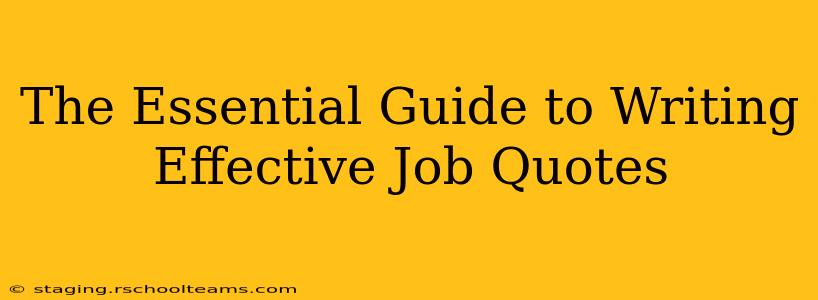Winning contracts hinges on submitting compelling job quotes. This comprehensive guide dives deep into crafting quotes that not only accurately reflect your costs but also persuasively showcase your value proposition, leading to increased win rates and a thriving business. We'll explore everything from understanding the client's needs to presenting your proposal in a professional and persuasive manner.
What Makes a Job Quote Effective?
An effective job quote is more than just a list of prices; it's a persuasive document that convinces the client you're the best choice for the job. It should clearly outline the scope of work, detail your pricing structure, highlight your expertise, and build trust. Think of it as a miniature business proposal tailored to a specific project. This requires careful planning and precise execution. We'll cover each of these critical aspects in detail.
Understanding the Client's Needs: The Foundation of a Winning Quote
Before even thinking about pricing, thoroughly understand the client's requirements. This involves more than just reading the job description. Ask clarifying questions. Explore their expectations. Understanding their vision is crucial for tailoring your quote to perfectly address their needs. This proactive approach demonstrates your professionalism and commitment, increasing your chances of securing the contract. A poorly understood brief leads to a poorly crafted quote, ultimately resulting in lost opportunities.
How to Gather Information Effectively:
- Detailed Questionnaires: Develop comprehensive questionnaires to unearth every detail of the project.
- On-site Visits: Whenever possible, conduct on-site visits for a firsthand assessment of the project's specifics.
- Active Listening: Pay close attention during calls and meetings, actively listening to the client's needs and concerns.
- Follow-up Questions: Don't hesitate to ask clarifying questions to ensure a complete understanding of the project scope.
Breaking Down the Scope of Work: Clarity is Key
Ambiguity breeds misunderstandings and disputes. Your quote needs to explicitly outline every aspect of the work you'll perform. This detailed scope of work should be clear, concise, and unambiguous, leaving no room for misinterpretation. Using bullet points, numbered lists, and clear headings makes it easier for the client to digest the information.
Essential Elements of a Detailed Scope of Work:
- Specific Tasks: Clearly list each task involved in completing the project.
- Materials & Resources: Specify all materials and resources required, including brands and quantities where applicable.
- Timeline: Provide a realistic and achievable timeline with key milestones.
- Assumptions & Limitations: Clearly state any assumptions you've made and any limitations to your services.
- Exclusions: Explicitly state what's not included in your quote to avoid future disagreements.
Pricing Your Services: Balancing Profitability and Competitiveness
Pricing is a delicate balance between profitability and competitiveness. Thoroughly research your market to understand prevailing rates. Account for all costs, including labor, materials, overhead, and profit margin. Several pricing models exist, and selecting the right one depends on your industry and the project's nature.
Common Pricing Models:
- Hourly Rate: Charge a fixed hourly rate for your services.
- Fixed Price: Quote a fixed price for the entire project, which requires a very detailed scope of work.
- Value-Based Pricing: Set prices based on the value you deliver to the client. This requires demonstrating the return on investment of your services.
Presenting Your Quote Professionally: First Impressions Matter
The visual presentation of your quote is just as important as its content. Use professional templates, ensuring clean formatting and easy readability. A well-designed quote reflects your professionalism and attention to detail.
Key Elements of a Professional Quote Presentation:
- Professional Letterhead: Use professional letterhead with your company logo and contact information.
- Clear and Concise Language: Use plain language that's easy for the client to understand. Avoid jargon.
- Logical Structure: Organize your quote logically with clear headings and subheadings.
- Professional Design: Use a clean and professional design with a consistent font and layout.
Handling Objections and Negotiating: Turning Challenges into Opportunities
Be prepared to address client objections and engage in constructive negotiation. Listen carefully to their concerns, address them with professionalism, and offer solutions where possible. Negotiation doesn't always mean compromising your profitability; it's about finding a mutually beneficial agreement.
Following Up: Maintaining Momentum
After submitting your quote, follow up promptly. A timely follow-up demonstrates your interest and commitment. Don't be afraid to reiterate your value proposition and address any outstanding questions.
This comprehensive guide provides a strong foundation for crafting effective job quotes. Remember, a well-written quote is a powerful tool that can significantly increase your chances of winning contracts and growing your business. By focusing on understanding the client's needs, clearly outlining the scope of work, and presenting your quote professionally, you can transform your job quotes from mere price lists into persuasive documents that win you more business.
